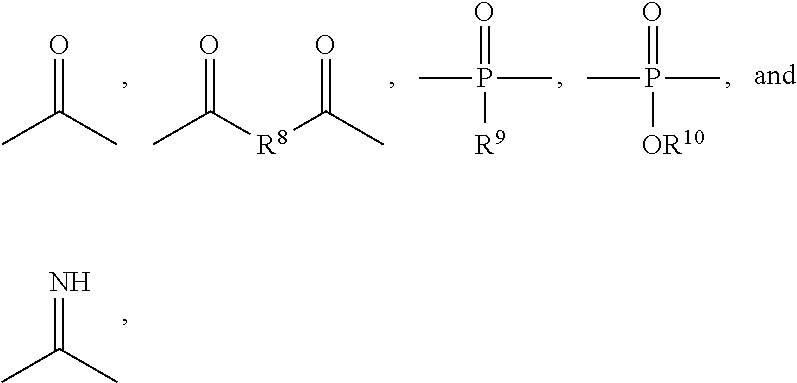Polymeric biomaterials derived from monomers comprising hydroxyacids and phenol compounds and their medical uses
a technology of phenol compounds and biomaterials, which is applied in the field of polymeric biomaterials derived from monomers comprising hydroxyacids and phenol compounds and their medical uses, can solve the problems of bioresorbtion and/or biodegradation tending to alter mechanical properties, difficult thermal processing, etc., and achieves flexibility and degradability. , the effect of providing rigidity and mechanical strength
- Summary
- Abstract
- Description
- Claims
- Application Information
AI Technical Summary
Benefits of technology
Problems solved by technology
Method used
Image
Examples
example 1
Preparation of Tyrosyl Lactate282 (TyLactate282)
[0200]In a 2-L 3 necked flask equipped with a overhead stirrer, a nitrogen inlet adopter and a thermometer were placed 720.65 g (5.00 mol) of L-lactide, 690.35 g (5.00 mol) of tyrosol and 2.03 g (5.00 mmol) of Snatioctoate. The flask was maintained under a slight positive pressure of nitrogen and immersed in an oil bath. While stining the contents of the flask the temperature of the oil bath was raised to 130° C. and maintained at that temperature for 3 h. The flask was then cooled to room temprature and the contents were dissolved in 3 liters of dichloromethane (DCM). The resulting, solution was added to 6 liters of heptane with stirring. The supernatant was siphoned out and the precipiate was stirred with 3 1 L portions of hepane and dried in a vacuum oven at 35° C. for 24 h. HPLC showed approximately 6-8% unreacted tyrosol, 35% of tyrosyl lactate, 36% of tyrosyl dilactate and higher oligomers. The results are confirmed by its 1H NMR...
example 2
Preparation of Tyrosyl Glycolate254 (TyGlycolate254)
[0201]Tyrosyl Glycolate254 was prepared using procedure similar to that used for Tyrosyl lactate282 above. In a 1 L 3 necked flask equipped with an overhead stirrer, a nitrogen inlet adopter and as thermometer were placed 174.1 g (1.5 mol) of glycolide. 207.1 g (1.5 mol) of tyrosol and 0.6 g (1.5 mmol) of Sn(II)octoate. The flask was maintained under a slight positive pressure of nitrogen and immersed in an oil bath. While stirring the contents of the flask the temperature of the oil bath was raised to 140° C. and maintained at that temperature for 4 h. The flask was then cooled to room temprature and the contents were dissolved in 800 mL of dichloromethane (DCM). The resulting solution was added to 1.6 liters of beptane with stirring. The supernatant was siphoned out and the precipiate was stirred with 500 mL of hepane 3 times and then dried in a vacuum oven at 35° C. for 24 h. E NMR spectrum showed approximately 6% unreacted tyro...
example 3
Iodination of Tyrosyl Lactale282
[0202]Iodination of Tyrosyl Lactate282 is carried out using known procedures, 200 mL of KlCl2 solution (2M) is added to 56.4 g (0.2 mol) of Tyrosyl Lactate282 in 250 mL of 95% ethanol and stirring the resulting solution for 1 h. It is then treated with 400 mL of water and the oil that separates is stirred with 100 mL of 2% sodium thiosulfate solution for 2 h. The brown solid obtained is dissolved in ethanol and treated with charcoal and filtered and evaporated to dryness to obtain diiodotyrosyl lactate282. The product is characterized by hple and NMR.
PUM
| Property | Measurement | Unit |
|---|---|---|
| biocompatible | aaaaa | aaaaa |
| bioresorbable | aaaaa | aaaaa |
| radio-opacity | aaaaa | aaaaa |
Abstract
Description
Claims
Application Information
 Login to View More
Login to View More - R&D
- Intellectual Property
- Life Sciences
- Materials
- Tech Scout
- Unparalleled Data Quality
- Higher Quality Content
- 60% Fewer Hallucinations
Browse by: Latest US Patents, China's latest patents, Technical Efficacy Thesaurus, Application Domain, Technology Topic, Popular Technical Reports.
© 2025 PatSnap. All rights reserved.Legal|Privacy policy|Modern Slavery Act Transparency Statement|Sitemap|About US| Contact US: help@patsnap.com



